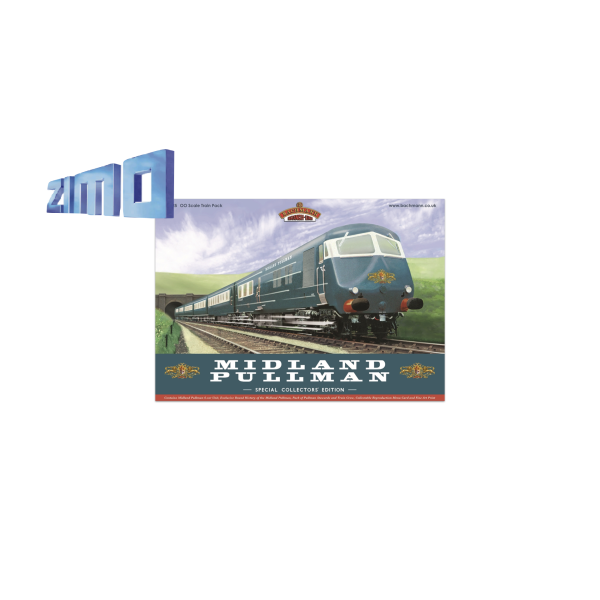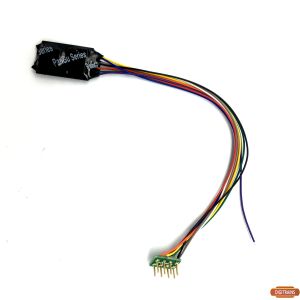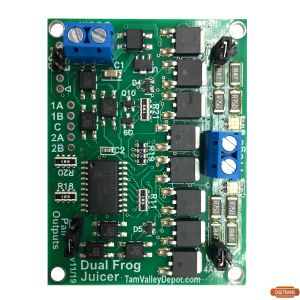ZS251AP Blue Pullman ProtoDrive Version 17.10 for Twin decoders
Please spend a few moments to read these notes which have been produced so that you may obtain the maximum satisfaction from your new sound scheme.
The sounds should work perfectly when the decoder is fitted correctly. Individual locos may require some fine tuning that you can achieve with your DCC controller.
What is ProtoDrive ?
This is a system developed to allow more prototypical sounds to be deployed across a wide range of operating conditions.
The sounds have been programmed in such a way that you, the user, may change the way that the sounds respond to your driving style or needs. This avoids the need for reprogramming and all the additional costs that would imply.
Please note that in all driving schemes listed below, small speed step increases or decreases will normally produce the best results in terms of matching sounds to loco movement.
Some of the new controls will not operate correctly if you use 14 or 28 speed steps. Please ensure you use 127/128 speed steps to get maximum advantage of these important additions.
Throttle Response Scheme.
Use F1 to switch on the sound. The engine in the ‘leading unit’ will start first, followed by that at the other end. After the start-up routine the traiin will stand with the diesel engines, the Prime Movers (PMs), ticking over at idle.
The sounds will respond to the throttle control in the following way:
Select speed step 1. The brakes will release, the PMs will increase power to get the loco moving, and will continue until at higher speed, a further ramp up will be initiated until the final high speed running sounds begin. The precise speed steps will depend upon your model, so I suggest you make a note of the actual figures for your later use.
The sounds will spool down at similar points on deceleration.
There are extra control features to further enhance your driving pleasure.
Coast Mode
No matter what actual speed your model is travelling at, or which engine note range is playing, pressing F key 6 will put the sounds into ‘Coast Mode’ by spooling down the sounds to the appropriate level.
You still have full control of the speed, but the coasting sound will continue until you switch off F key 6; at which point the sounds will change to those relevant to the current speed. (Which may include standing).
Hint. Try using F key 6 to spool engine sounds down before throttling down to a halt – no more thrashing locos standing at signals or platforms. Remember to release F key 6 before setting off again!
Note: This remains true and can be used in all cases from all speeds, but an alternative and automatic feature now spools the engine down to idle prior to stopping, provided the initial speed is not too high. See below.
Notch Down
If that wasn’t enough control to shake a stick at, there’s more!
During any driving sound ‘loop’, at any speed, it is possible to cause the engine power to spool down to the level immediately below. This is easily achieved by reducing the speed by one step, or more. E.g., if the loco is playing power band 3 sounds, reducing speed with your throttle by one step will cause the sound to immediately spool down to the sound of power band 2, if in power band 1, it will spool down to idle, and so on.
This is a different control to F6 which always spools down to idle/coast.
A further difference is that IF you have spooled down with this technique, acceleration of one speed step or more will immediately ramp the sound back up to the higher power. So you can now, at any road speed, vary the engine note by reducing or adding a single speed step.
It’s now down to your skill and knowledge to simulate any eventuality!
Multi-Mode
Engaging F7 will alter several driving characteristics simultaneously. The train will be capable of movement up to circa speed step 50 without the engines increasing in power. However, if you put it an increase in speed steps of say 10-12 in one action, the PMs will rev up to partial or full power (depends how many speed steps input) for a few seconds and then spool down automatically to the appropriate power for the requested speed.
This needs a little practice, but once mastered it can be used to simulate a train accelerating, then reducing power as it gets under way for noise abatement reasons.
This is a different action to F6, (which overrides any other control) and is used to hold sound at idle indefinitely.
Special Sound Techniques for twin decoders
Using two decoders gives more scope to enhance the sound ‘experience’. In particular, horns and diver’s door sounds will only play at the ‘leading’ end, whichever direction of travel. You don’t have to think about this, they change automatically with your direction control.
Please note that if any sound key remains ‘latched’, even if its sound is not playing, changing direction will also cause that sound to play which may not be what you require. Ensure all ‘ended’ sounds are switched off before changing direction.
Other sounds may be different at each end, brake release, spirax valves and flange sounds for example, yet both play together. They are different, but complementary, samples, used to illustrate in sound that each power car although to the same design, has slight differences from the other.
Brakes
Closing the Regulator cuts off the power supply (steam) to the cylinders. Locomotives and rolling stock have a high mass and will continue to drift for long distances unless some opposing force is applied.
Locomotive and or train brakes are the way in which the crew can apply a variable retarding force to overcome this momentum.
The ability to automatically simulate coasting with a heavy train has a profound impact on the perceived mass of any model, but particularly so for the smaller gauges. By default, the momentum is set high to achieve this prototypically extended coasting effect.
With high momentum there is a need for a counteracting force to retain control of stopping distances. A Brake Key feature is included and is operated with F key 2.
This key was chosen since most DCC controllers have the facility for F2 to be either ‘latching’’ or ‘momentary’. The latter mode is preferable for the braking function since it is operative only whilst pressed, disengaging immediately when released.
Here’s how it works.
Reduce the Regulator opening, to zero if you wish to come to a halt. The sound will change as previously described and model will very gradually decelerate. A short ‘dab’ of the Brake Key will produce a short brake application sound and a short period of braking. A longer brake application will extend the brake sound duration and provide a more powerful retarding force; the model will visibly slow down. A sustained application will provide maximum braking force and the model will decelerate rapidly in a controlled emergency stop.
Auxiliary Engines
Powering coach lighting and especially air-conditioning from the main engines’ generators reduced the power available for traction considerably.
To avoid this, auxiliary engines were fitted below some cars, as included in the model. F13 provides the sound of these supplementary power supplies. Unlike the real trains, you can decide whether to use them or not.
F Key Function/Sound
0 Exterior, Coach and Cab Lights
1 Sound On/Off
2 Brakes (see text for explanation)
3 Single Horn
4 Acknowledgement Horn
5 Single Horn
6 Coast On/Off
7 Multi-mode (See Text)
8 Table Lamps
9 Flange Squeal (Variable duration)
10 Air Brakes
11 Brake squeal
12 Spirax Valves
13 Auxiliary Engines
14 Station Ambience
15 Fans
16 Compressor
17 Guard’s whistle
18 Door open and slam
19 Fade All Sounds
20 Detonators
Driving Technique
At any time, and in any sound set, F6 will force the sounds to either hold idle or spool down to idle sounds. This affects only the sounds, actual speed is unaltered.
So, you can engage F6 before moving and the sounds will continue at idle even when the loco moves. Use this for light engine movements, where no extra power is required.
Or you can use F6 when already moving and the sounds will revert to idle for Coasting.
Releasing F6 in both cases allow the sound to go to the appropriate power level determined by the throttle position.
A new feature allows the power to drop to the next power level below if you decelerate by one speed step. Acceleration of one speed step allows the sound to return to the higher power. This works in any power band. Useful to switch between power levels at speed.
Try this:
Engage F6 before driving off. Accelerate to speed step 40, release F6. The power will instantly begin to rise to full power.
Repeat the above, but before releasing F6, reduce the speed step to 39. Now the power will ramp up to the intermediary power only. Increase speed step to 40 and it will rise again to full power.
Or this:
If you reduce speed gradually before stopping, the project will put the loco automatically into Coast mode at low speed, enabling a dignified halt without the engine sounds playing at full power. This is an automatic, low speed, alternative to manually controlled coasting using F6.
Remember. These new features will not operate correctly in 14 or 28 speed step modes. Using 126/127 speed step mode also allows imperceptible speed changes which nevertheless still trigger the sounds to change as described.
Paul Chetter
Lincoln
17 October 2017





